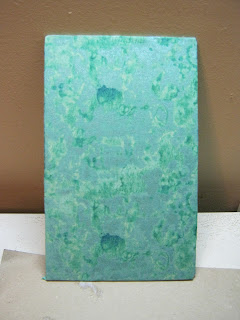As you've probably already guessed, I'm a huge advocate of using recycled materials in artwork. I've tackled the subject before- you can save a lot of money if you gather up the right (free) materials. One thing I'm especially enthused about is preparing my own canvases for artwork. Why buy an overpriced piece of primed cardboard when you can create a unique canvas for a fraction of the price? In this tutorial, I'll explain how I "wrap" scraps of wood (or even cardboard) with fabric to create a wonderful surface for almost any medium or style.
For my project I decided to create a cute little mutant deer painting out of india ink, acrylics and gesso. It's just one example out of an endless variety of possibilities. Try your own combinations. You didn't have to pay for this canvas, so why not experiment a little?
Things you'll need:
 | |
| After you have a good piece of scrap wood, get some mod podge and a really cool piece of fabric. You may also need gesso to prime your fabric (not pictured here.) Optional: Get your iron out, too. |
Preparing your surfaces:
 |
| Building up layers will make the bleeding effect look cool. |
Squirt some gesso into your favorite paint palette. I wouldn't suggest trying to directly apply it to your fabric because it will not spread on evenly and will likely bleed through the front (something you want to avoid!)
Instead, get your paintbrush fairly wet, scoop up some gesso and begin to paint it on the back of your fabric. The idea is to put on enough to make the fabric stiff, but not saturated with gesso. If done correctly, not a spot of white will show up on the front of your canvas.
(BTW, I explain gesso more thoroughly in a previous post if you're curious.)
Putting it together:
 |
| Apply a thin layer of mod podge to the board. You need a smooth, even coat. If you apply it too thick, it will seep into your fabric and show through the front. |
Wrapping the edges:
 |
| With your board turned over, add mod podge to one of the sides. You can add as much as you want here since this part won't be showing. Don't forget to get the edge, it will also need to be glued! |
 |
| This picture is showing two of the flaps glued down. |
 | |
| Fold the border flap over and press it firmly onto the back of the board. You can further stabilize it by adding even more mod podge over top of the flap. | . |
 |
| Continue gluing down the edges. Make sure the
fabric is pulled crisply over the edge.
|
Folding the corners over:
 |
| The border's excess material will become your canvas' corner. First, apply mod podge to where the corner will be. |
 |
| With a little bit of manipulation, the corner will naturally fold into a triangular shape. |
 |
| Pull the corner tight and press the fold down onto your canvas. |
 |
| Add more mod podge over top and underneath the fold to keep it stuck down. The tighter the fold is adhered, the crisper your canvas corners will be. |
The Finishing Touches:
 |
| Pretty legit canvas ready for some art work! |
 | |
| TADAH! After all the corner are glued down, this is the outcome.. |
 |
| Here are my final results... That's one horny deer! |






5 comments:
wow!!! very creative...i am going to consider fabric to paint on.
what is also fun is that your canvas isn't limited to the same sizes they sell at the store....i always wanted to buy the humongous size but hated that crazy price they throw on it....u had me thinking about that all day yesterday.
thats a great idea boho. you probably could save a butt load of money if you had enough supplies to do the job! It would take a little bit more mod podge and fabric, for example, but that would still be really cool. You could also probably attach the fabric it with a stapler gun.. that might be easier for the bigger canvases.
you can also make your own modge podge.... google it. you'll see. Then you can save even MORE money! Thanks for the post. I will use.
That's the upcycling spirit!! :B I love the idea of using all reduced cost items, even the glue.I would be curious to see how that turned out.
Post a Comment